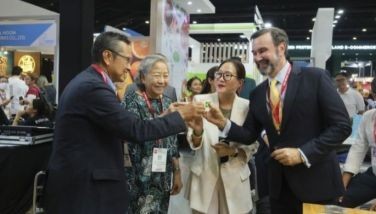The legacy of Fr. Boy Galindez
CEBU, Philippines - Fr. Ambrosio “Boy” Galindez was a well-loved and respected Augustinian priest during his time at the Basilica del Santo Niño de Cebu, and even up to this date.
For all his many works at the Basilica, among the most memorable was the Basilica del Santo Niño Museum which he established in 1965 in time for the 4th centenary of the Christianization of the Philippines.
According to the Basilica’s history, Galindez pushed for the establishment of the museum during his time so that the church will have somewhere to store, preserve and exhibit its religious artifacts, especially those that are related to the Holy Child.
Galindez, in an article by Elmer Lendo published in Confessiones on April 2008, was touted as an Augustinian priest who pioneered the creation of the new province, and spearheaded religious-cultural activities not only in Cebu but also in Iloilo and other areas where he was assigned.
He was also described as the “Katipunero” of our new province.
Galindez’ priesthood started in 1947 after he graduated from Grade 7. His brother, who reportedly encouraged him to join the seminary, was also a seminarian.
He joined the diocesan seminary in Cebu, which at that time was in Argao.
After his second year at the seminary, he took a vacation and went home to Garcia Hernandez in Bohol, where he was teased by his brother in front of their visiting relatives from Canada that he was gay.
To prove that he was not gay, the young Galindez decided not to return to the seminary to start his third year and instead took three girlfriends. The girls, however, found out about it and fought each other prompting the young seminarian to go back to the seminary.
Upon his return, Galindez met an Augustinian priest named Fr. Moran, who was looking for young boys to become priests.
“For me this is providential so I took the chance in going back to the seminary but at this time a religious one, not as a diocesan,” said Galindez in that interview.
Then he went to Intramuros, Manila and after a year of postulancy, he became a novice in 1952, and took his profession of vows. From 1953 to 1956, he enrolled in Philosophy at the University of Santo Tomas.
After spending three years in UST, the Vicar Provincial of the Philippine Province told him to study Italian. After one month of learning the language, the Vicar told him to tell his parents that he was going to Italy to study.
He was the first Filipino Augustinian to be sent to Rome in 1956, where he stayed for four years to study Theology.
Galindez said that during that time, he was the only Filipino in the community while the rest were Americans, Spaniards, Germans, Belgians, Mexicans and others.
“They look down on me. One of the Americans teased me by saying, ‘You! Monkey from the Philippines?” he recalled.
He said he had to challenge the American to a fistfight, which abruptly stopped the teasing.
“We have to be brave sometimes because otherwise, people, especially from other countries, will put us down,” he said.
The young Galindez persevered while at the International College in Sta. Monica in Rome. He was ordained as a priest in 1959.
He was then invited by then Fr. Provincial in Spain to come to Spain, where he stayed for one year and two months. He also studied in Salamanca for one year for his licentiate in Philosophy.
After finishing his studies, he was told to go home.
Back home, Galindez said his first assignment was in Cebu, particularly the Basilica del Santo Niño, as the Colegio del Santo Niño’s sports director.
There, he taught elementary students and became the secretary of the community comprised of Spanish Friars of the then Convento del Sto. Niño. He also served as the director of the Cofradia del Sto. Niño in Cebu.
In the Basilica, Galindez stayed for 16 years, before he was transferred to Iloilo where he founded the “Dinagyang” festival.
Dr. Jose Gullas, executive vice president of the University of the Visayas and chairman of The Freeman, said he has fond memories of Galindez who was a close confidant of his parents, Don Vicente and Inday Pining.
Gullas recalled that his father once shared a story about the time when he took Galindez to a tour around Cebu shortly after he arrived from Spain.
“Gi-tour ni Papa Enting, whole day, sa Cebu ug Mactan. But after the tour, Fr. Galindez said, ‘Noy Enting, taga Bohol intawon ko,’” Gullas said, laughing.
He said his father had no inkling that Galindez was from Bohol as he spoke Spanish fluently. At that time, most Cebuanos, if not all, were also well versed in this foreign language.
Gullas said the priest was “very kind,” that he was prompted to help him in his museum projects.
Galindez passed away on June 12, 2011.
“I have gone to many communities. I have been through many complex experiences brought about by various circumstances as we go along our religious journey with others. But what is the best guide for us to live rightly is to follow the rule in general and the Constitutions in particular. It is the basic framework of how we are supposed to perform tasks expected of us. On the other hand, Augustine inculcates in us that the virtue of humility should illumine the evangelical vows we professed. In this way, we will live peacefully and harmoniously,” said Galindez when asked for a message to those who want to become priests like him during his interview back in 2008. (FREEMAN)
- Latest


























